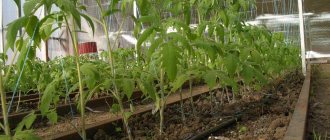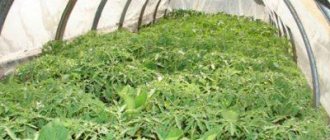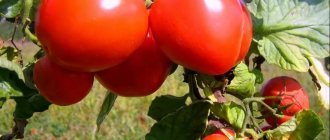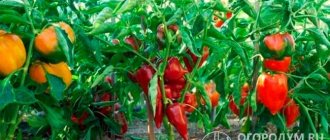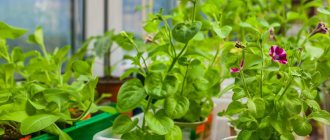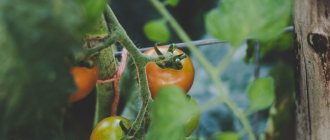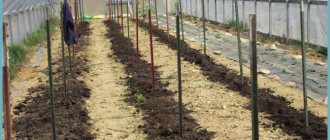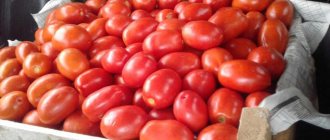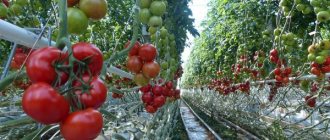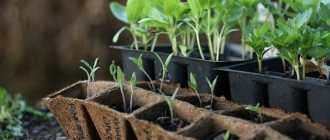Tomatoes are most often grown in ordinary beds, but in this case, the time for harvesting ripe tomatoes is postponed for a period that depends on the climate of the region. In some areas of our country, by the time grown tomatoes reach ripeness, late blight and cold weather begin to destroy them. Every gardener wants not only to grow, but also to harvest tomatoes earlier. Therefore, various designs for plant protection are common, allowing to plant tomato seedlings in a greenhouse in early spring. Stationary and temporary greenhouses, various greenhouses and temporary shelters are used not only in the north, where the heat comes late, but they are also relevant for the middle zone with a changeable climate.
A simple greenhouse, you can buy it in a store or make it yourself. A small structure suitable for growing tomatoes will not require much space, financial expenses or labor.
The greenhouse allows you to grow tomatoes from transplanting seedlings to harvesting a ripe harvest. If necessary, only tomato seedlings are grown in it before transplanting to the beds. The seedlings grow strong, well resistant to diseases and temperature changes.
What is a greenhouse and how does it differ from a greenhouse?
Both designs are designed to protect cultivated plants from adverse factors. But not all gardeners understand the difference between them.
Read about how to plant and grow tomatoes in a greenhouse here.
| Options | Greenhouse | Greenhouse |
| Heating | The temperature is maintained by the sun and mulch | Can be with or without artificial heating |
| Height | Small, sufficient for the development of plants until the cover is removed. In a full cycle, you can grow tomatoes and other garden crops only of low growth | Not lower than 2 m, often – 2.5, industrial greenhouse – 3.2 m. A person should be comfortable working |
| Width | Narrow. The greenhouse must be treated in such a way as not to step on the bed. | Any width |
| Ventilation | No windows or doors provided. You will have to remove the frame or film | A ventilation system must be equipped. You can open windows and doors |
| Mobility | Portable or permanent | Landline only |
| Landing Features | Most often, tomatoes are grown without additional equipment. | Often there are racks or high beds |
A greenhouse is a small-sized structure with side protection and a removable transparent roof. Served outside. Used for growing seedlings and low vegetables. Low-growing varieties of tomatoes can be planted in relatively tall structures.
Greenhouses differ in many ways, they are:
- cold or warm;
- stable or lightweight, with a cheap flexible frame;
- from film, glass, non-woven material, even polycarbonate;
- double or single slope, arched;
- independent structures or adjacent to the wall of the building.
Greenhouses made from stretch film have the cheapest coating, retain heat well, but are inconvenient to use. It is difficult to ventilate the structure without damaging the material; it is impossible to remove or open it slightly; removable parts must be provided. Stretch film is more suitable for cheap unheated greenhouses.
In modern gardening, greenhouses are especially in demand in regions with short or cold summers. Large quantities of seedlings are grown in them, and low-growing vegetables or herbs are planted in a full cycle.
Determining deadlines according to folk signs
In nature, there are many signs that determine the timing of planting seedlings in open ground. The following signs are known:
- Tomato seeds are sown for seedlings when the snowdrop begins to bloom.
- Tomato seedlings are planted in the ground at the beginning of flowering of rosehip and poplar. These plants bloom when the threat of frost has passed.
- The flowering of chestnut, lilac and rowan also indicate that it is time to plant tomato seedlings in garden beds.
To get a decent tomato harvest, you need to thoroughly study the needs of the plant, choose varieties of different ripening periods that are suitable for your region, and properly prepare the substrate for seedlings and seed material.
Today we talked about the timing of sowing seeds for seedlings and when to plant tomatoes in open ground and a greenhouse. Follow our recommendations and the result will definitely be good.
Victor Immel My entire childhood was spent in nature, which probably predetermined my subsequent choice of profession - to become an agronomist. ...
Timing for planting seedlings and sowing seeds in a greenhouse
When to plant tomatoes depends on the region and the weather forecast. Under the film you can:
- sow seeds;
- pick seedlings;
- grow tomatoes before moving them to the garden;
- get a harvest of low-growing varieties.
If you prepare the greenhouse correctly, you can plant the seeds first, at above-zero temperatures. The tomatoes dive, warming the soil inside the structure to at least 15° C. The same number of degrees is needed to plant the plants.
It can be quite cold outside at this time. Since the room is not heated, it will be necessary to raise or maintain a suitable temperature at night artificially, but without heating devices.
Tomatoes under film in the middle zone and more northern regions can be planted in May, especially in warm spring - not earlier than the end of April. In the south, seeds are sown as soon as frost stops on the ground (naturally, the ground needs to be warmed up first).
Grown tomatoes are planted in greenhouses based on the long-term weather forecast. Now the climate is changing, often in warm regions spring is short - as soon as the snow melts, the heat immediately sets in.
Tomatoes can be protected from return frosts. Often this is even easier to do under a small film cover than in an unheated greenhouse.
Tomato varieties for greenhouses
The success of growing vegetables and the amount of mature harvest depends on how well the variety is chosen. The best ones for planting are:
- Alliance F1, Sweet Bunch, Miracle of the Earth, Pink Raisins - early;
- Nevsky, Bull's Heart, Blagovest - mid-season;
- King, Mikado, Sevruga - large-fruited.
Excellent varieties for planting in a greenhouse are also:
- Eagle Heart;
- Koenigsberg;
- Abakan pink;
- Chio-chio-san;
- Yablonka Russia;
- Monomakh's hat;
- Golden Kupala.
In the north it is better to plant early varieties of tomatoes, in the south - late ones. Mid-season varieties are suitable for central Russia.
Greenhouse and soil preparation
Before planting tomatoes in a greenhouse, it needs to be prepared. If everything is done correctly, you can move young plants or sow seeds for seedlings quite early.
Soil development
Plant tomatoes in warm, fertile, moist, loose soil. Bringing these parameters into line with cultural requirements requires separate consideration.
Improvement of structure and fertilization
There is no need to dig up the garden every year. Tomatoes and other annual crops growing in separate bushes are planted in holes, where organic matter and fertilizers are added, and that’s it. This is not done in protected ground.
The beds are completely dug up, preferably in the fall. Add organic matter and fertilizers:
- Do not add nitrogen to the soil at the end of the season - it will be washed away until spring;
- phosphorus and calcium, on the contrary, begin to “work” only after a long period; they are recommended to be added in the fall.
Once every few years you can completely change the substrate. Or you will have to move the greenhouse to a new location every season.
Moisture saturation
If winter is rich in precipitation, and gardeners live in a private house, it is enough to throw snow inside the structure. In the spring it will melt and the soil will be saturated with moisture. Otherwise, you will have to wet the bed at least enough to fill a spade. This is approximately 26 cm. In order for the water to reach the required depth, you will have to water it repeatedly.
Temperature increase
The faster the ground warms up, the sooner you can plant tomato seeds or seedlings. The temperature should be increased only after moisture charging:
- Pour hot water over the bed and cover with foil.
- Cover the area with black non-woven material. The method works exclusively in sunny weather; it will take a much longer period of time.
You will have to measure the soil temperature with a special thermometer. You can use the cheapest cooking probe.
To prevent the earth, which has been heated during the day, from cooling down at night, it is protected at sunset with an additional layer of insulation.
Disinfection
The soil, especially if nightshade crops were planted in the same place in the previous season, must be disinfected in any convenient way, for example, with solutions:
- copper sulfate;
- Fitosporina;
- Trichoderma;
- Carbation;
- Baikal.
You should first read the instructions for the selected drug. Some are used immediately before planting, others – at least a month in advance.
Greenhouse preparation
The structure needs the same care as a greenhouse. All parts, no matter whether they are removable or have stood all winter, and protective coating:
- cleaned mechanically;
- wash;
- disinfected.
Covering material is pulled over the arches 7-10 days before sowing or planting tomatoes.
Insulation
The greenhouse is designed to plant tomatoes or sow seeds as early as possible. It is not heated, therefore, it needs protection from sudden cold snaps, because if the threat of a critical drop in temperature did not exist, then the structure itself is not needed.
We'll have to keep an eye on the weather forecast. During the day, the sun heats the bed; when it’s cool outside, it’s hot inside. But at night, seeds and plants can freeze.
It is recommended to prepare warm old blankets and “out of order” outerwear in advance. As soon as a cold snap is predicted, the structure is insulated in the evening. When the sun comes out, the shelter is removed.
Picking
As for picking, every gardener has his own opinion. Some people think that this is unnecessary stress for a fragile plant, and they sow tomatoes directly into separate cups. Others argue that picking is akin to natural selection; the strongest tomato bushes survive.
The positive side of the procedure is that after planting tomato seedlings in larger containers, the root system develops better.
The procedure should be carried out at the stage when the bush has formed three true leaves. But some sprouts develop faster than their counterparts and are ready for transplantation in 7-9 days. However, there is no need to rush, since the root system of the sprouts is still very weak and can be seriously injured. But at the same time, it is worth considering that at the age of 21 days, the roots of densely sown tomatoes begin to intertwine with each other. Picking in this case greatly injures the plants.
Reference! The optimal age of tomato seedlings for transplanting is 12-15 days.
Before transplanting, prepare a container with moistened soil in advance. During the day, tomato seedlings are well watered (this makes the soil not very heavy, as if watering is carried out immediately before the procedure). To remove a tomato sprout from a small bowl, you need to grab it by the base of the stem and gently pull it up, helping from below with a small scoop.
Then lower the bush down to the cotyledon leaves into a previously prepared hole, sprinkle with soil and compact it a little.
When planting tomato seedlings for a greenhouse in peat tablets, when picking, it is necessary to remove the protective film from them and place them in soil prepared according to all the rules.
Growing seedlings in a greenhouse
Tomato seedlings under the film rarely stretch out and become fatty, and are easy to harden. Such planting material will be purchased first on the market.
Sowing seeds
Algorithm for planting tomatoes in a greenhouse:
- Markings are carried out on the dug up and fertilized bed.
- The furrows are drawn at a distance of at least 10-11 cm from each other.
- Spill hot water.
- Allow the liquid to be absorbed.
- Place the seeds at a distance of at least 1 cm.
- Cover with substrate.
- Water for better adhesion of grains to the soil.
You can additionally mulch the bed with dry sifted mullein.
Seedling care
The greenhouse is not opened until the shoots appear. As soon as the tomatoes hatch, they begin to lift the top or ends:
- for ventilation;
- to equalize the temperature outside and inside.
When it’s 15-20°C outside, it can be as high as 50 degrees in the greenhouse on a sunny day. If you leave the structure closed, the tomatoes may “cook”.
Ventilation is provided only in the morning. It’s too late to do this at 10-11 o’clock - the temperature inside will be so high that the seedlings will get a shock and may not survive. At the very least, the leaves of the tomatoes will curl.
Water the greenhouse in the morning or evening. An additional danger of lack of ventilation is that damp soil without access to fresh air can turn green, that is, become covered with moss or algae. They block the supply of oxygen to the roots and can themselves cause problems.
If you plant seeds in a greenhouse, tomatoes usually do without pinching. To prevent stretching and to grow additional roots, add bedding. First prepare the substrate:
- sifted garden soil (not from nightshade crops) - 1 bucket;
- sand – 3 l;
- humus - 3 l;
- ash - 0.5 cups.
The filling is done like this:
- Water the tomatoes the day before.
- Mulch the bed so as to completely hide the subcotyledonous knees under a layer of substrate. The lower leaves should remain on the surface.
- Gently moisten the soil through a fine sprayer.
If the water jet is strong, the tomatoes will be washed to the ground. They are unlikely to be able to straighten themselves, but they will continue to grow, and as a result they will turn out crooked.
Raising seedlings with your hands or a stick is a long task, and for elderly people or with a bad back it is not easy. It’s better to carefully water it from a watering can by hand.
In the phase of 3-4 true leaves, they begin to feed with a mineral complex with a predominance of nitrogen. If the bed has not been filled with phosphorus fertilizers since the fall, the element is given in a form that is easily digestible by plants.
Expert opinion
Maria Nikolaevna
Experienced vegetable grower. 40 years of experience. Graduated from Michurinsk State Agrarian University (MICHGAU)
Ask a Question
We must not forget that tomatoes absorb most nutrients at temperatures of 15 ° C and above. If it is cold, fertilizing will not have an effect, but when it gets warm, the seedlings will “shoot” and begin to develop rapidly.
Weak and deformed seedlings are removed. Tomatoes are thinned out - brown spots often appear on closed leaves. In any case, preventive treatment must be included in the care package.
How to soak seeds
Soaking is one of the mandatory and most effective preparation methods. The benefits of this procedure are beyond doubt. The only question is which method is most useful.
There are two classic soaking methods:
- The first is bubbling - placing seeds in water for 14 - 18 hours and artificially saturating it with oxygen. To do this, use an aquarium with a compressor.
- The second method is regular seed germination. They are placed in a bag and moistened. Leave in a warm place for about 15 hours. After this time, sprouts should appear. As soon as this happens, you need to start sowing immediately.
Less traditional soaking methods include folk recipes. Soaking in a solution of wood ash helps increase germination. It is simple to use: soak the seeds for several hours in a solution, to prepare which a teaspoon of ash is added to a glass of water.
I recommend watching the video (be sure to watch it to the end), you will learn a lot of new things:
The awakening of the seeds is facilitated by adding honey or aloe juice to the water. You need to soak them in the resulting mixture.
Soaking in potato juice is used. Before squeezing juice from root vegetables, they need to be frozen. Then proceed according to the standard recipe.
Other folk methods of soaking for the purpose of awakening and disinfection:
- Aging in onion peel infusion;
- Soaking in mushroom broth;
- Placement in compost tea;
- Soaking in ammonium nitrate.
Many experienced gardeners trust only specialized store-bought products. All of the above methods give positive results.
Growing tomatoes in a greenhouse
You can grow young tomatoes under film. Or plant low-growing varieties there to get a harvest.
Preparing seedlings for moving
The principle of preparing for transplanting into a greenhouse or from a film shelter to a garden is the same: tomatoes need to be hardened and fed. Those grown in the house are taken out onto the street or balcony. During the day, the protective film is removed from the structure or one of the side walls is removed - it all depends on the model.
First, the plants spend 20 minutes in the air, then the time is gradually increased. The tomatoes should spend the last nights uncovered or outside.
A few days before transplanting, the seedlings are fed and watered. It is not recommended to moisten the soil the day before - slightly wilted tomatoes are less likely to break when moved to a permanent place.
Common mistakes
A few words about typical mistakes when planting tomatoes indoors:
- The greenhouse or greenhouse is not prepared properly. The walls must be washed and disinfected, since harmful fungi and bacteria may have remained on them from last season.
- Planting plants too close to the wall. The greenhouse will get very hot in the summer; if the tomatoes sit too close to the glass or polycarbonate, then over time they will grow and their leaves will touch the walls. This can lead to burns to the leaf blades.
- Trellis are not used. This cannot be called a complete mistake. But the design of a protected greenhouse means that tomatoes can be tied up. This will allow you to grow tall varieties and get more yield.
- There is no hardening procedure for tomatoes. In order for tomatoes to better tolerate transplantation, they need to be hardened, that is, gradually accustomed to new growing conditions.
- Thickened plantings. Tomatoes lack nutrition in the soil and are poorly ventilated. As a result, the plants' immune system weakens, and they become easy prey for pathogenic microflora.
